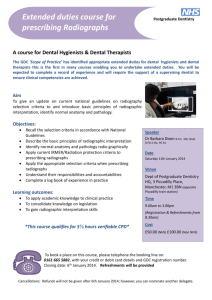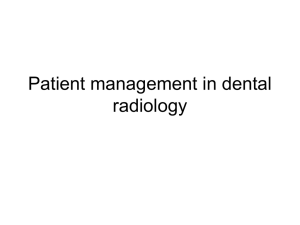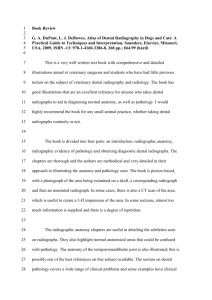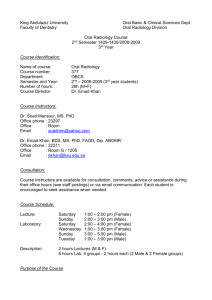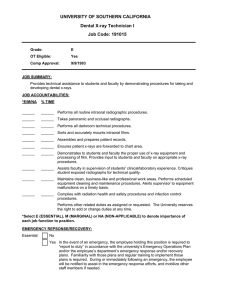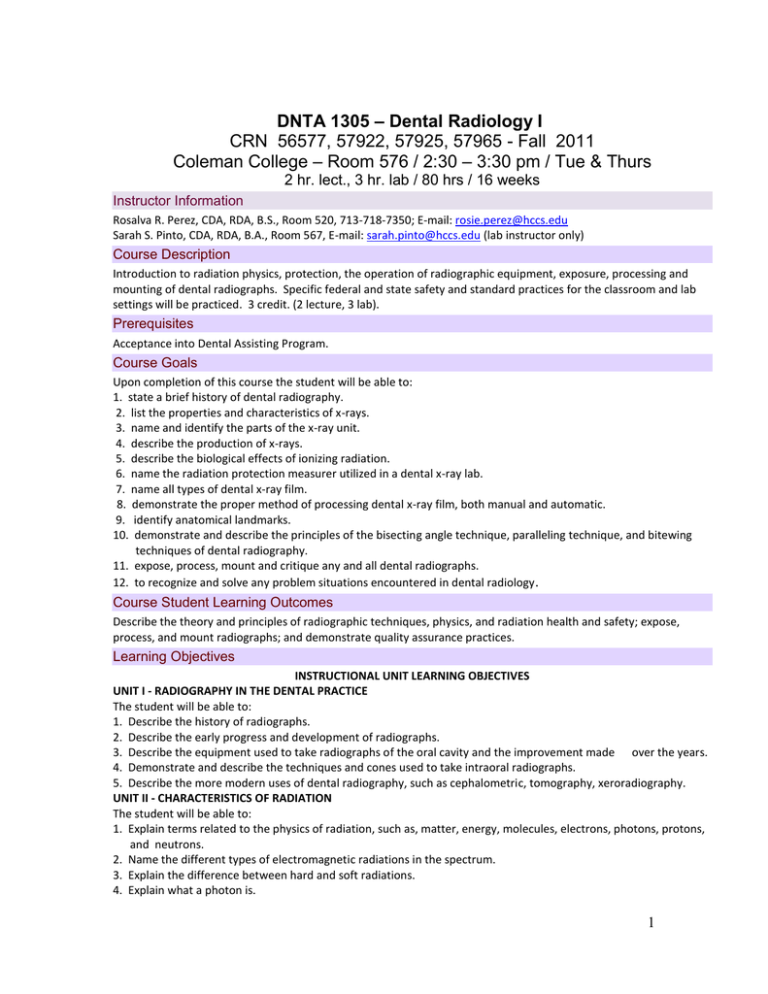
DNTA 1305 – Dental Radiology I
CRN 56577, 57922, 57925, 57965 - Fall 2011
Coleman College – Room 576 / 2:30 – 3:30 pm / Tue & Thurs
2 hr. lect., 3 hr. lab / 80 hrs / 16 weeks
Instructor Information
Rosalva R. Perez, CDA, RDA, B.S., Room 520, 713-718-7350; E-mail: rosie.perez@hccs.edu
Sarah S. Pinto, CDA, RDA, B.A., Room 567, E-mail: sarah.pinto@hccs.edu (lab instructor only)
Course Description
Introduction to radiation physics, protection, the operation of radiographic equipment, exposure, processing and
mounting of dental radiographs. Specific federal and state safety and standard practices for the classroom and lab
settings will be practiced. 3 credit. (2 lecture, 3 lab).
Prerequisites
Acceptance into Dental Assisting Program.
Course Goals
Upon completion of this course the student will be able to:
1. state a brief history of dental radiography.
2. list the properties and characteristics of x-rays.
3. name and identify the parts of the x-ray unit.
4. describe the production of x-rays.
5. describe the biological effects of ionizing radiation.
6. name the radiation protection measurer utilized in a dental x-ray lab.
7. name all types of dental x-ray film.
8. demonstrate the proper method of processing dental x-ray film, both manual and automatic.
9. identify anatomical landmarks.
10. demonstrate and describe the principles of the bisecting angle technique, paralleling technique, and bitewing
techniques of dental radiography.
11. expose, process, mount and critique any and all dental radiographs.
12. to recognize and solve any problem situations encountered in dental radiology .
Course Student Learning Outcomes
Describe the theory and principles of radiographic techniques, physics, and radiation health and safety; expose,
process, and mount radiographs; and demonstrate quality assurance practices.
Learning Objectives
INSTRUCTIONAL UNIT LEARNING OBJECTIVES
UNIT I - RADIOGRAPHY IN THE DENTAL PRACTICE
The student will be able to:
1. Describe the history of radiographs.
2. Describe the early progress and development of radiographs.
3. Describe the equipment used to take radiographs of the oral cavity and the improvement made over the years.
4. Demonstrate and describe the techniques and cones used to take intraoral radiographs.
5. Describe the more modern uses of dental radiography, such as cephalometric, tomography, xeroradiography.
UNIT II - CHARACTERISTICS OF RADIATION
The student will be able to:
1. Explain terms related to the physics of radiation, such as, matter, energy, molecules, electrons, photons, protons,
and neutrons.
2. Name the different types of electromagnetic radiations in the spectrum.
3. Explain the difference between hard and soft radiations.
4. Explain what a photon is.
1
5. Explain the difference between characteristic and bremsstrahlung radiations.
UNIT III - THE DENTAL X-RAY MACHINE - COMPONENTS AND FUNCTIONS
The student will be able to:
1. Name the parts and components of the x-ray machine.
2. Explain the principles of x-ray tube operation.
3. Describe the care of the x-ray equipment.
UNIT IV - TECHNICAL ASPECTS OF RADIATION PRODUCTION
The student will be able to:
1. Describe the operation of the x-ray machine.
2. Describe the purpose of filtration in producing good radiographs.
3. Describe the purpose of collimation in producing good radiographs.
4. Explain the difference between contrast and density.
UNIT V - DENTAL X-RAY FILMS
The student will be able to:
1. Describe the composition of dental x-ray film.
2. Describe the types of film coverings available.
3. Describe the correct storage of films.
4. Explain the different film speeds available, and tell which is more beneficial for the patient.
5. Describe the many types of intraoral films.
6. Describe the many types of extraoral films.
7. Describe the process for duplicating films.
UNIT VI - DENTAL X-RAY FILM PROCESSING
The student will be able to:
1. Explain the importance of correct safelighting and filters in the darkroom.
2. Describe the care and maintenance of the processing tanks.
3. Describe the correct processing procedures for manual processing of dental films.
4. Describe rapid processing procedures.
5. Describe the procedures for automatic processing.
UNIT VII - IDENTIFICATION OF LANDMARKS
The student will be able to:
1. Identify the anatomical landmarks of the skull.
2. List the landmarks of the maxillary arch.
3. List the landmarks of the mandibular arch.
4. Explain the mounting procedure for radiographs.
UNIT VIII - INTRAORAL RADIOGRAPHIC PROCEDURES
The student will be able to:
1. Explain the bisecting the angle technique and name the instruments used with this technique.
2. Explain the paralleling technique and name the instruments used with this technique.
3. Explain the possible problems that can occur when incorrect vertical and horizontal angles are used.
UNIT IX - EFFECTS OF RADIATION EXPOSURE
The student will be able to:
1. Explain the effects of radiation on somatic and genetic cells.
2. Describe the direct-hit theory.
3. Explain the dose-response curve.
4. Explain the difference between short-term and long-term effects of radiation.
UNIT X - RADIATION PROTECTION
The student will be able to:
1. Describe the different forms of radiation measurement.
2. Define the radiation safety terminology.
3. Explain the radiation protection measures for operator and patient.
4. Describe the radiation monitoring devices and their importance in radiation safety.
2
SCANS or Core Curriculum Statement
SCANS (Secretary’s Commission on Achieving Necessary Skills)
A study was conducted for the Department of Labor by the American Society for Training and Development, which
identified the seven skills U.S. employers want most in entry level employees. These skills are: motivation to learn
basic skills, communication, teamwork, critical thinking, career development and leadership. In order to achieve the
desired competencies, the following will be included in this course:
I. Maximize Resource Allocations
A. Allocate time - Attempt and complete assignments on time.
B. Allocate material and facility resources - Assemble appropriate PID's for taking radiographs. Clean x-ray rooms
and darkroom.
II. Use Information Skills
A. Maintain information - will maintain records of films taken and organize self as to be prepared to take required
films.
B. Interpret information/Communicate information - interpret and communicate radiographic procedures with
instructors.
III. Employ Interpersonal Skills
A. Participate as a team member - Work with other students and faculty, as well as, the clinical affiliates.
B. Correct performance - Take required radiographs on manikins and critique and mount them.
IV. Use Technology
A. Maintain technology/Troubleshoot technology - maintains, clean and fill radiographic processor.
V. Enhance Basic Skills
A. Use writing proficiency - take written quizzes and exam; take lecture and laboratory notes.
B. Perform listening skill - listen to lecture by instructors and/or guest speakers.
C. Demonstrate speaking competence - explain procedures required.
D. Demonstrate reading competence - read all assigned materials.
VI. Apply Thinking Skills
A. Use problem-solving skill - be able to critique and correct errors made on radiographs by recognizing the
problem.
VII. Display Appropriate Personal Qualities
A. Demonstrate appropriate social skills - work as a team member and be polite to fellow classmates and
instructors.
B. Display integrity/honesty - choose appropriate course of action when faced with an ethical dilemma.
Course Calendar
PLANNED CLASS SCHEDULE
FALL 2011
WEEK
TOPIC
TEXT ASSIGNMENT
____________________________________________________________________________________________
WEEK # 1
LECTURE: Intraoral Radiographic Procedures
Chpt. 12,13,14
LAB: Introduction to lab and radiation health and
safety procedures to be followed while in lab and con’t
of chpts. 12-14; position and expose incisor radiographs
WEEK# 2
LECTURE: History of Dental Radiology
LAB: Position and expose max. and mand.
incisors and maxillary canine radiographs
Chapter 1
WEEK# 3
LECTURE: Characteristics of Radiation
LAB: Position and expose maxillary and
mandibular canine radiographs
Chapter 2
3
WEEK # 4
LECTURE: TEST # 1
LAB: Review positioning of canines and
position and expose maxillary premolars
WEEK # 5
LECTURE: X-ray Machine Components
LAB: Review maxillary premolars and position
and expose mandibular premolars
Chapter 3
WEEK # 6
LECTURE: Producing quality Radiographs
LAB:
Review positioning of premolars and
position and expose molar radiographs
Chapter 4
WEEK # 7
LECTURE: Anatomical Landmarks and Mounting
LAB: Review positioning of molars and
Position and expose bitewing radiographs
FMS # 1 Due
Chapter 18,19
WEEK # 8
LECTURE: TEST # 2
LAB: Position and expose incisors, canines,
and premolars
WEEK # 9
LECTURE: Dental X-ray Film
LAB: Position and expose molar and bitewing
radiographs.
FMS # 2 Due
Chapter 7
WEEK # 10
LECTURE: Film Processing
LAB: Work on FMS # 3
Chapter 8
WEEK # 11
LECTURE: TEST # 3
LAB: FMS #3 Due
WEEK # 12
LECTURE: Infection Control
LAB: Work on FMS # 4
Chapter 9
WEEK # 13
LECTURE: Quality Assurance
LAB: FMS # 4 Due
Chapter 17
WEEK # 14
LECTURE: Effects of Radiation Exposure,
Radiation Protection.
LAB: Work on FMS # 5 and turn in
Chapter 5
Chapter 6
WEEK # 15
LECTURE: TEST # 4
LAB: Lab final
WEEK # 16
FINAL EXAM
4
Student Assignments and Course Requirements:
See Course Calendar for weekly assignments.
Each student is required to expose, process, mount and critique at least 3 sets of adult radiographs (on the manikin)
with a grade of 83% or better in order to be eligible to take the radiography competency exam. Each student must
successfully complete the radiography competency exam (see below) prior to enrolling in Dental Radiology II.
The competency exam will consist of:
1. The student will be given no more than 1 and 1/2-hour time limit to expose, manually process, mount and critique
radiographs.
2. The student must successfully complete the competency exam with 83% accuracy in order to successfully
complete this course.
Student Assessment(s):
Exams and quizzes consisting of many testing formats such as, multiple choice, true/false, essay, matching labeling
and/or short answer questions. Students will be advised of average at mid-semester and again near the end of the
semester.
Instructional Materials
Required textbooks:
1. Johnson and Thomson, Essentials of Dental Radiography for Dental Assistants and Hygienists, 9th ed., Pearson
Prentice Hall, 2012.
2. Bird and Robinson, Modern Dental Assisting, 10th ed., Elsevier Saunders, 2012.
HCC Policy Statement: ADA
“Any student with a documented disability (e.g. physical, learning, psychiatric, vision, hearing, etc.) who needs to
arrange reasonable accommodations must contact the Disability Services Office at the respective college at the
beginning of each semester. Faculty is authorized to provide only the accommodations requested by the Disability
Support Services Office. The information in this publication will be made available in large print, taped or computerbased format upon request.” Regina Ricks, 713-718-7430, is the ADA Counselor for Coleman Campus.
HCC Policy Statement: Academic Honesty
“Students are responsible for conducting themselves with honor and integrity in fulfilling course requirements.
Penalties and/or disciplinary proceedings may be initiated by College System officials against a student accused of
scholastic dishonesty.” See the HCCS Student Handbook for further information.
HCC Policy Statement: Student Attendance, 3-Peaters, Withdrawal deadline
HCC POLICY STATEMENTS: ATTENDANCE
Research has shown that the single most important factor in student success is attendance! Therefore, attendance
and punctuality are mandatory. HCCS policy states that students absent from this course for more than 12.5% of the
total hours of instruction will be administratively dropped. This class has 80 contact hours. A student may be
dropped after 10 hours of absence from lecture.
If a student enters the class more than thirty minutes after the class has begun or leaves more than thirty minutes
early, they will be counted absent on that day.
Poor attendance records tend to correlate with poor grades. If you miss any class, you are responsible for all
material missed. It is good idea to find a friend or a buddy in class who would be willing to share class notes or
discussion or be able to hand in paper if you unavoidable miss a class.
5
HCC POLICY STATEMENTS: 3-PEATERS
The State of Texas encourages students to complete college without having to repeat failed classes. To increase
student success, students who repeat the same course more than twice, are required to pay extra tuition. The
purpose of this extra tuition fee is to encourage students to pass their courses and to graduate. Effective fall 2006,
HCC has been charging a higher tuition rate to students registering the third or subsequent time for a course. If you
are considering course withdrawal because you are not earning passing grades, confer with your
instructor/counselor as early as possible about your study habits, reading and writing homework, test taking skills,
attendance, course participation, and opportunities for tutoring or other assistance that might be available.
HCC POLICY STATEMENTS: WITHDRAWAL
If you feel that you cannot complete this course, you will need to withdraw from the course prior to the final date of
withdrawal. Before you withdraw from your course, please take time to meet with the instructor to discuss why you
feel it is necessary to do so. The instructor may be able to provide you with suggestions that would enable you to
complete the course. Your success is very important. Beginning in fall 2007, the Texas Legislature passed a law
limiting first time entering freshmen to no more than SIX total course withdrawals throughout their educational
career in obtaining a certificate and/or degree.
To help students avoid having to drop/withdraw from any class, HCC has instituted an Early Alert process by which
your professor may “alert” you and HCC counselors that you might fail a class because of excessive absences and/or
poor academic performance. It is your responsibility to visit with your professor or a counselor to learn about what,
if any, HCC interventions might be available to assist you- online tutoring, child care, financial aid, job placement, etc.
– to stay in class and improve your academic performance.
If a student feels that they cannot complete the course, he or she will need to withdraw from the course prior to the
final date of withdrawal. Before withdrawing, the student should meet with the instructor to discuss the decision.
After withdrawal, the student must meet with the department head to complete an exit interview.
HCC Student Services Information
HCC has instituted an Early Alert process by which your professor may “alert” you and HCC counselors that you might
fail a class because of excessive absences and/or poor academic performance.
Peer tutoring may be available through the Academic Success Center, contact the program office for further
information.
Instructor requirements
Examination questions will be taken from the reading assignments as well as material presented in class. THERE
WILL BE NO MAKE-UP EXAMINATIONS AVAILABLE. Late homework will be accepted with 10 points off for every day
late, until graded homework is returned. After graded work is returned, no assignments will be accepted.
Periodic quizzes will be given to continually access student understanding of materials, and cannot be made up if
missed. Students who are late or absent and miss a quiz will receive an “0” for that quiz.
Program/Discipline Requirements
See the Dental Assisting Program Student Handbook
HCC Dental Assisting Program Grading Scale
GRADING:
The final grade for this course will be calculated according to the total number of points accumulated for
participating in class activities, quizzes and exams. All students must make "C" or better to successfully complete this
course.
Points may be earned by:
Major Examinations (4 exams)
300 points
Possible 100 points each exam
(Lowest grade will be dropped
in lieu of make-up exams)
*Laboratory
500 points
6
Unannounced quizzes in lecture (average of all)
100 points
FINAL EXAM (lecture)
100 points
______________________________________________________________
TOTAL POINTS
1000 points
*Laboratory grade is 50% of total final grade.
GRADING SCALE:
To earn an:
A accumulate 900 - 1000 points - excellent
B accumulate 800 - 889 points - above average
C accumulate 700 - 799 points - average
F accumulate 0 - 699 points - below average
All students must make "C" or better to successfully complete this course.
Instructor Grading Criteria
Assignments turned in late will be lowered by 10 points for each day that it is late.
7

